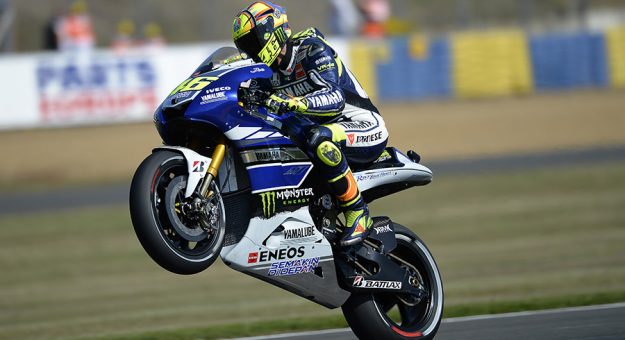American Kenny Roberts Jr. said he knew that if he was going to win a world championship, 2000 was going to have to be the year.
“We looked at Valentino coming and said, ‘Well we’d better do everything to get it done this year,’” Roberts recalled. “Because we knew how talented he was and once he had a season on the 500s, there was no way anyone was going to beat him.”
Roberts did win the championship in 2000 with Rossi the runner-up in his rookie year in the premier class. The second half of the season things began to click for Rossi — he won two rounds and was on the podium in every race he finished. To say he was quickly adapting to the big bikes was an understatement.
And as Roberts predicted, Rossi became untouchable. Starting in 2001, he completely took over the premier class and won five world championships in a row. Then, after losing out to American Nicky Hayden in 2006 and Australian Casey Stoner in 2007, Rossi came back and won two more world titles in 2008 and ’09.
Along the way Rossi enjoyed great rivalries, first against fellow Italian Loris Capirossi, then against Max Biaggi, Sete Gibernau, Stoner, an often-tense relationship with his own teammate Jorge Lorenzo, and finally some epic battles against next-generation MotoGP great Marc Marquez.
Rossi has always raced with the No. 46, the number his father often used. Traditionally, the world championship winner would run the No. 1 on their motorcycle for the next season. However, in a homage to Britain’s Barry Sheene, who was the first rider of the modern era to keep the same number (No. 7), Rossi has stayed with the now-famous No. 46 throughout his career, though, as the world champion he has worn the No. 1 on the shoulder of his racing leathers.
Rossi became known as the “Doctor,” even though no one really remembers why. He often jokes that the nickname stuck because in Italy Rossi is a common surname for doctors.
Rossi toyed with the idea of switching to auto racing and once even made an impressive and highly publicized Formula 1 test. Michael Schumacher hailed Rossi as having immense talent and said he would be perfectly capable of moving to Formula 1 and being competitive immediately.
But Rossi was in such demand in MotoGP that he really could not afford to leave the sport. Motorcycle racing made Rossi a very rich man, unquestionably the highest paid motorcycle racer of all time.
Rossi earned $34 million in 2007 and $36 million in ’08. During his peak he was one of the highest-earning sports figures in the world, according to Sports Illustrated. In 2009, he was ranked as No. 9 among the world’s highest-paid athletes.
However, his immense wealth generated legal disputes over his residency and how much tax he owed in Italy. The legal battle eventually resulted in a massive $40 million fine for Rossi in 2008.
“I am happy with how this issue has been resolved,” Rossi said. “It is a high figure, but it is more important to be calm, serene and happy.”
Rossi will always be remembered for his racing accomplishments. His seven premier class titles are second only to another Italian great Giacomo Agostini, who earned eight world titles in the 500cc class. But Rossi’s 89 wins in the premier class, make him far and away No. 1. Agostini is second with 68 wins and Marquez is third with 57.
There are arguments for Agostini and, perhaps, Marquez in some circles, but most pundits say Rossi is the greatest MotoGP racer in history.
Rossi even changed the style of motorcycle road racing. He introduced the leg dangle, where riders pull their feet off the peg and dangle a leg off to the side while braking for turns. Avid fans will always recall when Rossi first performed the move, perhaps by accident, at Jerez in 2005.
Today, many top road racers in championships around the world use the leg dangle to help them slow for a turn and to create a wider profile, making it tougher for following riders to pass.
Rossi will still be around the paddock as a team owner, but it will be interesting to see if the popularity of MotoGP, which has largely been immune to the downturn other major motorsports have suffered since the recession of the late 2000s, will be able to continue without its most popular rider.
Veteran Grand Prix reporter and book author Michael Scott put things in perspective when he wrote about Rossi’s retirement in Cycle News: “Race attendances and TV figures peaked for Rossi, even when his results slumped. Dorna will be hard pressed to absorb his absence. This is a problem a long time in the making. The question has often been raised: What happens when Rossi goes? Now we find out.”
